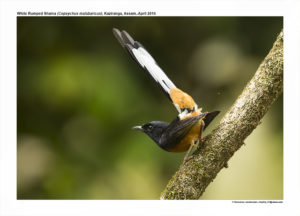White-rumped Shama

White-rumped Shama Copsychus malabaricus
Etymology:
- Copsychus : Greek word for Blackbird
- Malabaricus : From Malabar region in Kerala, India
Vernacular Names: Hindi: Shama, Sans: Shyama, Ben: Shama, Ass: Shama sorai, Guj: Shyama, Shama, Mar: Shyama, Ta: Solaipadi, Te: Podanalanchi, Tonka nalanchi, Mal: Shamakkili, Sinh: Wal-polkichcha
Distribution in India: Resident of Himalayan foothills, North East ,East and Western Ghats in India.
Description: Size of 21–28 cm, wt. of 22–42 g. It has a long graduated tail. The male of nominate race has glossy blue-black hood to back, less glossy grey-black wings and tail, white rump and white outer rectrices. The mid-breast to vent is orange-rufous, thighs are whitish, bill is black, legs are pinkish, and eyesare dark brown. The female is like the male, but matt grey on hood to back and wings, tail is shorter and overall slightly greyer. The juvenile is blackish brown with few buff streaks above, buff with brown scales from chin to breast and flanks, whitish belly to vent, tail as female but shorter; eye is grey
Habitat: It is found in undergrowth of logged and un-logged mixed forest, teak forest, mixed bamboo forest, secondary jungle, clearings in forest, overgrown tree plantations,mangroves, coastal vegetation and tidal riverine swamp-forest. It is found from lowlands to 1750 m.
Food habits: It eats arthropods like ants, caterpillars, moths, beetles, flies, grasshoppers, centipedes, spiders, also worms and berries. The young are fed earthworms and burrowing beetle larvae. Itforages on ground and in low vegetation, gleaning from leaves and earth, occasionally sallying after flying insects. It is crepuscular.
Breeding habits: They breed in Apr–Jun in India and Sri Lanka; May–Jul in China; Mar–May in Myanmar; Mar–Aug in Peninsular Malaysia, Sept–Oct and Jan–May in Borneo, Apr in Sumatra and May and Aug in C Java. The nest is a shallow cup of rootlets, fibers, grass, bamboo leaves, etc., placed up in natural hollow in tree trunk likes old woodpecker holes, stump top or base of bamboo clump. The nest is constructed by both sexes, although only female gathers materials. They lay a clutch of 2-4 eggs, laid at 24-hour intervals, with incubation commencing with final egg. The incubation period is 13–15 days. The nestling period is 11–13 days. Post-fledging dependence of chicks on parents is up to 26 days, juveniles remain within natal territory for up to 54 days.